 |
|
Israel Journal COLLEEN TINKER |
||||
NUMBER 7 — MONDAY, NOVEMBER 3, 2008
Election in the USA, Madaba, Mt. Nebo, and Petra at night
Good morning—or good evening, friends! It’s 5:11 AM on November 4, (election day for us Americans), here. I’m sorry I didn’t get this written last night, We went on a candlelight walk into the ancient carved city of Petra last night, and we got back a bit after 10:30. With my still-unsettled sleep patterns, I couldn’t stay awake—literally—to put two sentences together. So here I am!
Yesterday as we drove out of Amman we followed the route the children of Israel followed during their wilderness wanderings. As we drove toward the high point of our day, a visit to Mt. Nebo where Moses died, our guide gave us some interesting facts.
Amman, which gets its name from “Ammon” (remember the Amonites?) was, in Greek times, called “Philadelphia”. It was not the Philadelphia in Turkey which was one of the seven churches in Revelation 1-2, but it was a Philadelphia. Now here’s the really interesting bit if information; this city was also called the “city of seven mountains” because of the geography of the area.
Remember in Revelation 12 the beast that comes out of the sea has seven heads, and the seven heads are seven hills on which the harlot sits? Some people (including Adventists) have long speculated that the city on seven hills is Rome, because it is literally built on seven hills. But I don’t think we can be certain of that identity—and to be sure, scholars are not agreed about it. I find it fascinating that this large capital city in Jordan also has been called the city of seven mountains. I suspect we won’t know for sure what that description in Revelation 12 means until the events actually unfold.
Fifty percent of the population of Jordan is Palestinian; the rest is comprised of Cassion, Sessions, Armenians, and Jews—but mostly Bedouins. Bedouins today, he told us, are no longer nomads. They are often tent-dwellers, but they have become permanent residents of their areas, and many are going to school adopting professions. The nomads in Jordan today, he said, are mostly Gypsies who come in from neighboring countries to make money during olive harvest. He stressed, however, that all the permanent residents are first and foremost Jordanian!
Also, about 7% of the Jordanian population is Christian, and that percentage is comprised of Orthodox, Catholic, Lutheran, and other denominations. He also explained that they consider themselves, as Muslims, to be the continuation of the same religion of the prophets descended from Abraham. They believe Moses and Jesus were important prophets, and they must “believe” in them (as prophets) to be Muslim. Their prayers always end with a request for God to bless the people of Mohammed as He blesses the people of Abraham. Thus, he stressed, they do not consider themselves anti-Semites because they also are Semites and the cousins of the Jews.
Our guide also told us that Muslims pray five times a day: sunrise, noon, afternoon, sunset, and nighttime. Moreover, they use the lunar calendar for their church calendar. Thus their prayer times and festivals vary. For example, the lunar calendar determines that for the next ten years, Ramadan will be more difficult for them because it will fall in the summer instead of winter. Thus, their month of daytime fasting will be many hours longer because sunset will be nearer 8:00 PM than the winter-rime 4:30.
St George’s and Mt. Nebo
Our first stop was at St. George’s Greek Orthodox Church in Madaba where an ancient Byzantine mosaic is preserved. This mosaic, which had been part of an ancient church floor, dates from sometime between the fourth century and the seventh century. It was discovered during the preparation for building a later church, and part of it was destroyed. But the remaining section (which is the largest section) is an amazing, detailed map of the holy land depicted pictorially. Our guide explained that this mosaic was a pilgrim’s map, showing the Christian travelers where the significant Biblical events happened in the holy land. In later years, this mosaic helped archeologists find several “lost” places that the map recorded accurately.
We finally reached the focal point of our journey yesterday: Mt. Nebo. You remember the story: the Israelites clamored for water, and in his anger, Moses struck the rock twice and said, “Shall we bring water for you…?”
Gary pointed out that Moses failed, at that point, to honor God’s sovereign power by including himself as part of the solution for bringing the water. Further, he didn’t act in trust by simply asking God to bring the water. He struck the rock—twice—inserting himself into the equation instead of doing what God told him to do the way God told him to do it. Because of this disregard for God who is sovereign, God told him that because he had not upheld God as holy, he would see but not enter the Promised Land.
Nevertheless, for 39 years Moses had served God by leading the children of Israel, and God’s discipline of Moses was not a rejection of him. When Moses reached the age of 120 years, he reiterated the covenant with them. You can read his final words to Israel in Deuteronomy 32 and 33. He recited the history of God’s leading the nation out of bondage, and he reminded them that by the word of God they would live long in the land they would possess.
That very day God told Moses, “Go up into the Abarim Range to Mount Nebo in Moab, across from Jericho, and view Canaan, the land I am giving the Israelites as their own possession. There on the mountain that you have climbed you will die and be gathered to your people, just as your brother Aaron died on Mount Hor and was gathered to his people. This is because both of you broke faith with me in the presence of the Israelites at the waters of Meribah Kadesh in the Desert of Zin and because you did not uphold my holiness among the Israelites. Therefore, you will see the land only from a distance; you will not enter the land I am giving to the people of Israel” (Deut. 32:49-52).
Israel mourned Moses for 30 days, and at the end of the mourning period, Joshua took up the leadership of Israel and led them into the land of Canaan. Moses doubtless told the Israelites that he would be going up the mountain to die, and they likely watched him disappear from their sight as he climbed the mountain to view the land and then to die.
As we stood on top of Mt. Nebo, it was moving and surprising. We really could see the entire land of Canaan, from the Dead Sea on the south, up the Jordan River valley with the distinct strip of green that marks its path, to the verdant area of Dan on the north. We could see the backside of the Mt. of Olives which hid Jerusalem from our view. We could see Jericho across the Jordan—the city God would deliver into their hands under Joshua’s leadership. We could see the hills of Gilead, and right below us, between Nebo and the Jordan, were the plains of Moab where Israel had camped.
Gary commented that as Americans, we love the idea of intimacy with God, but we don’t do well with the ideas of reverence and awe of Him.
Petra at night
We stayed the night at Petra, the ancient city carved into the sides of towering limestone cliffs and mountains. Today we will officially tour Petra, and I’ll write more tonight. I can just say that last night, walking into the hidden city through a long (a mile or so?) corridor of soaring limestone cliffs engineered with water conduits and ancient cobblestones by the light of 1500 luminarias placed along the road was a breath-taking experience. We stopped in front of the Petra treasury, the columns and lintels and doorways carved right into the rock, and the rooms are hidden inside the mountains.
I am struck by the juxtaposition of the legacy of God’s revelation of Himself in this land with the persistent presence of man-made religion and human glory. This has been the story of humanity. My prayer is that I will be humble and submitted to the Lord God and that He will glorify Himself through His body even as the politics and economic circumstances of the world careen around us. We serve the only sovereign God—the God who is triune and eternal and sovereign over all our pretensions.
We can stand firmly, confident that the God who showed Moses the entire land of Canaan before taking him is also in the affairs of mankind today. He is already in the election outcome; He is already accomplishing His own purposes, and He has graciously given each of us a role in His story!
Copyright 1999-2008 Graphics Studio, Redlands, CA USA. All rights reserved. Revised November 17, 2008. Use of this site and forum signifies your acceptance of the Terms and Conditions. Send comments and questions to formeradventist@gmail.com
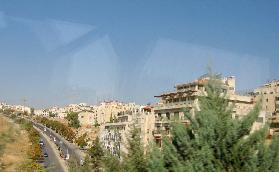
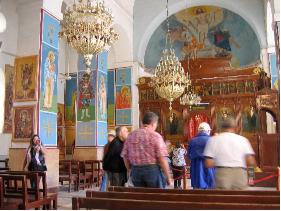
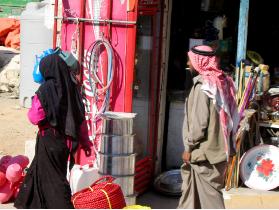 Coca Cola is everywhere!
Coca Cola is everywhere! The mosaic pilgrim's map in Madaba helped archeologists find "lost" Christian sites in the Holy Land.
The mosaic pilgrim's map in Madaba helped archeologists find "lost" Christian sites in the Holy Land.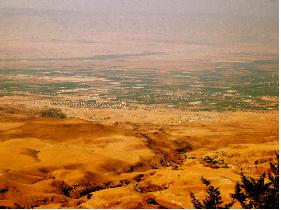 The view of the promised land from the top of Mt. Nebo, where Moses died just before the children of Israel crossed the Jordan River and entered the land.
The view of the promised land from the top of Mt. Nebo, where Moses died just before the children of Israel crossed the Jordan River and entered the land.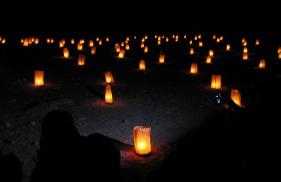 One thousand five hundred candle luminarias lit the path and the ancient carved buildings of Petra.
One thousand five hundred candle luminarias lit the path and the ancient carved buildings of Petra.